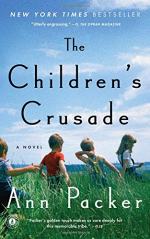|
This section contains 758 words (approx. 2 pages at 400 words per page) |

|
The Children's Crusade Summary & Study Guide Description
The Children's Crusade Summary & Study Guide includes comprehensive information and analysis to help you understand the book. This study guide contains the following sections:
This detailed literature summary also contains Quotes and a Free Quiz on The Children's Crusade by Ann Packer.
NOTE: All citations in this Study Guide refer to the Kindle version of The Children’s Crusade, published April 7, 2015.
“We never get over it … Having started out as children" (171). These are the words that Rebecca Blair’s analyst says to her during a therapy session. The Children’s Crusade by Ann Packer deals with all of the ways that parents influence their children — for bad and for good — and the ways that children influence their parents. The novel follows four siblings as they try to come to terms with the impact of their childhood when they are faced with the sale of the home in which they grew up. Themes in the novel include the importance of both a child’s nature and the way he is raised on his personality, the impact of the parent’s personality on child development, and the role of the mother in childhood.
Recently discharged from the Navy, Bill Blair bought a piece of land sheltered by a huge California live oak tree. He bought it on a whim, an unusual move for him, but he was motivated by an image of dozens of children playing on the property. He hoped that by changing his specialty to pediatrics, he could help children. Since he had worked as a doctor in the war he had been disillusioned by the cruelty and unnecessary death he had seen there. Bill hoped his new line of work would help to improve his outlook on life.
Bill married the backward Penny Greenway who imagined herself with children but lived more inside herself than in actual relationships. The two decided on three children, two boys and one girl. Instead, they had four children, three boys and one girl. Bill, who was better with the children, was away from home a good deal because of his job, but Penny worked full-time trying to take care of the children and her home. In the novel, the family’s story is told through the description of several incidents that happen during the course of their lives as a family. In the first incident, the children were upset because Penny had promised to let them help with party preparations but decided at the last minute it would be too hard and time consuming to teach them what to do. In another scenario several years later, the children became aware that their mother was drifting away from the family. They tried to come up with something she would enjoy doing with them so they could reunite their family. It is in this section that Penny decided she wanted to use a shed on their property as an art studio.
Penny moved further and further from her family both emotionally and physically as her children become teenagers, and then young adults. She spent more and more time in her art studio, even moving a bed in so she could sleep there at night. Of all of her children, Penny was most frustrated by James, the youngest. While the other children were relatively well behaved and followed career goals they had set for themselves, James floated through life with no real structure. He got in trouble for drunk driving and into physical altercations with his mother. Things reached a head when James tore up a painting that was a favorite of his mother. She responded by impaling his childhood security toy in one of her assemblages.
Penny believed James needed to be disciplined, but Bill did not believe in corporal punishment. She was frustrated because Bill wanted her to spend time with a family over which she felts she had no control. When she tried to connect with the family, Penny only felt frustrated and hurt. For this reason she immersed herself more and more into her career as an artist. She believed her art was her true calling.
The siblings began to think about their childhoods again when James told them he wanted to sell the house in which they grew up. Each of the children had his own opinion of James’ decision. However, by the terms of their father’s will, they could not refuse to sell. In order to sell the house, Penny also had to agree to the sale and would not do so if James would not come to see her in person. The two come to a sort of understanding, just as the other children do with the ghosts of their childhood during their process of coming to terms with the sale of the house.
Read more from the Study Guide
|
This section contains 758 words (approx. 2 pages at 400 words per page) |

|



